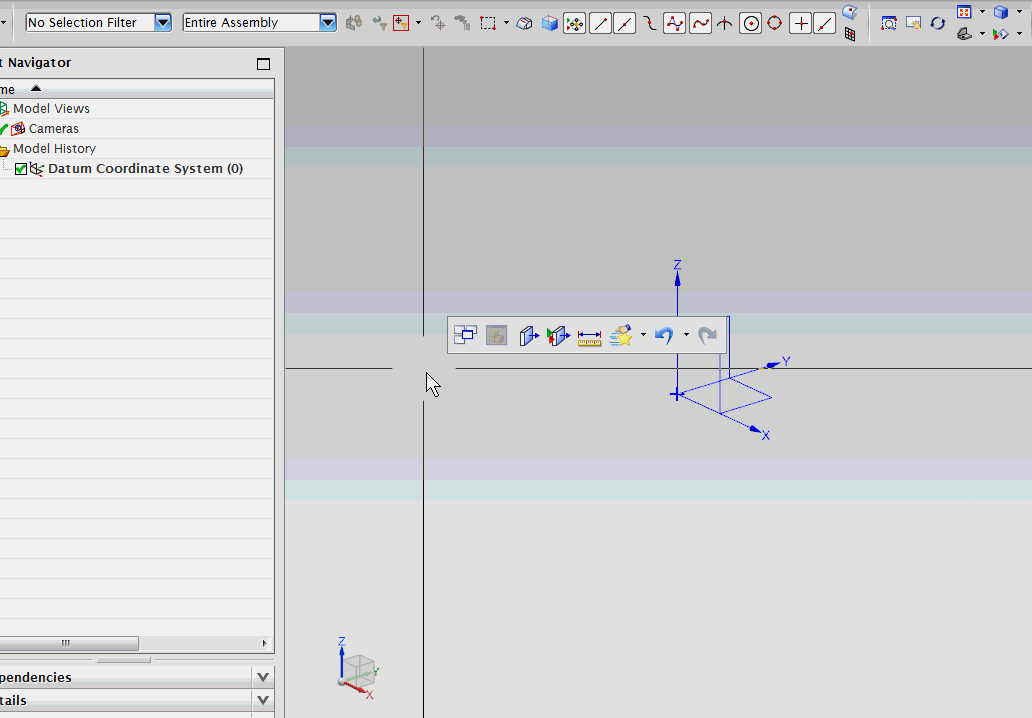NX二次开发-UFUN单对象选择对话框UF_UI_select_with_single_dialog
#include <uf.h>
#include <uf_ui.h> static int select_filter_proc_fn(tag_t object, int type[], void* user_data, UF_UI_selection_p_t select)
{
if (object == NULL)
{
return UF_UI_SEL_REJECT;
}
else
{
return UF_UI_SEL_ACCEPT;
}
} static int init_proc(UF_UI_selection_p_t select, void* user_data)
{
int num_triples = ;//可选类型的数量
UF_UI_mask_t mask_triples[] =
{UF_point_type, UF_point_subtype, UF_UI_SEL_NOT_A_FEATURE,
UF_line_type, UF_line_normal_subtype, UF_UI_SEL_NOT_A_FEATURE,
UF_solid_type, UF_solid_body_subtype, UF_UI_SEL_FEATURE_BODY
};//可选对象类型
UF_UI_set_sel_mask(select, UF_UI_SEL_MASK_CLEAR_AND_ENABLE_SPECIFIC, num_triples, mask_triples);
if ((UF_UI_set_sel_procs(select, select_filter_proc_fn, NULL, user_data)) == )
{
return UF_UI_SEL_SUCCESS;
}
else
{
return UF_UI_SEL_FAILURE;
}
} UF_initialize(); //单对象选择对话框
char sCue[] = "单对象选择对话框";
char sTitle[] = "单对象选择对话框";
int iScope = UF_UI_SEL_SCOPE_NO_CHANGE;
int iResponse;
tag_t tObject;
tag_t tView;
double adCursor[];
UF_UI_select_with_single_dialog(sCue, sTitle, iScope, init_proc, NULL, &iResponse, &tObject, adCursor, &tView); UF_terminate(); Caesar卢尚宇
2019年7月1日

附加代码
常用图纸视图类型
static int init_proc(UF_UI_selection_p_t select, void* user_data)
{
int num_triples = ;//可选类型的数量
UF_UI_mask_t mask_triples[] =
{ UF_view_type, UF_UI_SEL_NOT_A_FEATURE };//图纸视图类型
UF_UI_set_sel_mask(select, UF_UI_SEL_MASK_CLEAR_AND_ENABLE_SPECIFIC, num_triples, mask_triples);
if ((UF_UI_set_sel_procs(select, select_filter_proc_fn, NULL, user_data)) == )
{
return UF_UI_SEL_SUCCESS;
}
else
{
return UF_UI_SEL_FAILURE;
}
}
NX二次开发-UFUN单对象选择对话框UF_UI_select_with_single_dialog的更多相关文章
- NX二次开发-UFUN文件选择对话框UF_UI_create_filebox
NX11+VS2013 #include <uf.h> #include <uf_ui.h> UF_initialize(); //文件选择对话框 char sPromptSt ...
- NX二次开发-UFUN参数选择对话框UF_UI_select_parameters
#include <uf.h> #include <uf_ui.h> #include <uf_modl.h> UF_initialize(); //参数选择对话框 ...
- NX二次开发-UFUN打开选择文件夹对话框UF_UI_create_filebox
#include <uf.h> #include <uf_ui.h> #include <string> using namespace std; string O ...
- NX二次开发-UFUN拾取向量对话框UF_UI_specify_vector
#include <uf.h> #include <uf_ui.h> UF_initialize(); //拾取向量对话框 ], pnt[]; int mode = UF_UI ...
- NX二次开发-UFUN单选菜单对话框uc1603
NX11+VS2013 #include <uf.h> #include <uf_ui.h> UF_initialize(); //单选菜单对话框 char sPromptSt ...
- NX二次开发-UFUN拾取平面对话框UF_UI_specify_plane
#include <uf.h> #include <uf_ui.h> UF_initialize(); //拾取平面对话框 ] = { , , , , , , , , }; ] ...
- NX二次开发-基于MFC界面对话框与NX交互的开发
打开VS2013 点击新建,选择MFC DLL 点击确定 点下一步 什么都不改,直接点完成 进来之后先编译一下,看是否编译成功 打开项目属性,更改这几处 $(UGII_BASE_DIR)\ugopen ...
- NX二次开发-Ufun API Example
UF公共类型 UF_begin_timer计时函数 https://www.cnblogs.com/nxopen2018/p/10957135.html UF_end_timer计时函数 https: ...
- NX二次开发-UFUN发射线函数UF_MODL_trace_a_ray的用法
今天是国庆节,放假休息懒得动,没有出去玩,在家研究一下发射线函数UF_MODL_trace_a_ray.小弟以前在软件公司混的时候,当时我做的那个项目就用到了UF_MODL_trace_a_ray,当 ...
随机推荐
- python入门学习一
本文用来记录学习python过程中所遇到的不同的或者记忆不清的一些定义. 注释 注释用# #此处是注释 n = 123 f = 456 不转义 Python中r‘ ’表示字符串默认不转义 print ...
- js 循环json
var json= { "Type": "Coding", "Height":100 }; for (var key in json) { ...
- 小程序入坑(一)---如何引入iconfont 字体图标
最近一直忙于日常任务,其实是懒癌又犯了..........不过因为自己的“懒癌”,“不思进取”给自己挖了不少坑. 一,小程序工具的安装 打开简易小程序的官网https://mp.weixin.qq.c ...
- 「NOI2016」循环之美 解题报告
「NOI2016」循环之美 对于小数\(\frac{a}{b}\),如果它在\(k\)进制下被统计,需要满足要求并且不重复. 不重复我们确保这个分数是最简分数即\((a,b)=1\) 满足要求需要满足 ...
- 【LeetCode 7】整数反转
题目链接 [题解] 没什么说的. 就注意一点. 可以在*10+n%10的时候. 顺便判断有没有溢出. (直接用longlong可真是机制..) [代码] class Solution { public ...
- CF 。E2. Stars Drawing (Hard Edition) (DP)
Description: 定义一个星星由 '*' 组成,形状为一个对称的“十”字型,大小为星星 1/2 的横长(或纵长)减一(如题目中的图).给出一个 n*m 的图,判断是不是每一个 '*' 都能属于 ...
- CSS:CSS 字体
ylbtech-CSS:CSS 字体 1.返回顶部 1. CSS 字体 CSS字体属性定义字体,加粗,大小,文字样式. serif和sans-serif字体之间的区别 在计算机屏幕上,sans-se ...
- 23、css的定位问题
1.positon:relative相对定位 <!DOCTYPE html PUBLIC "-//W3C//DTD XHTML 1.0 Transitional//EN" & ...
- HTML —— 表格
复习下关于html中的表格. 基本结构: 表格由 table 标签为父标签进行包裹,可以在 table 上添加几种属性. border : 定义表格的边框. cellspacing : 间距,指单元格 ...
- 高级UI晋升之常用View(三)上篇
更多Android高级架构进阶视频学习请点击:https://space.bilibili.com/474380680本篇文章将先从以下两个内容来介绍常用View: [RecycleView] [Ca ...
